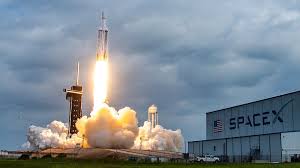1. A Spectacular Surge: SpaceX’s 2025 Launch Bonanza
SpaceX is redefining ambition this year—with a jaw‑dropping goal of 170 orbital launches in 2025, blowing past its 2024 record of 134 liftoffs. By mid‑June, the company had already completed 72 rockets, averaging one launch every 2.3 days. That pace means thousands of satellite deployments, crewed missions, and international partnerships are reshaping the space economy.
2. July Highlights: Starlink, NASA’s TRACERS & Crew-11
- Starlink continues to expand: A Falcon 9 lifted 28 new Starlink satellites on July 8 using booster B1077 (on its 22nd flight!) from Cape Canaveral. In California, a polar orbit mission launched 24 more Starlinks from Vandenberg on July 18 — the 30th such mission from VAFB in 2025.
- NASA’s TRACERS mission soars: On July 22, a Falcon 9 took off from Vandenberg carrying NASA’s TRACERS science satellites, plus three commercial payloads. The mission aims to study magnetic reconnection in Earth’s magnetosphere by measuring thousands of polar cusp crossings over the next year. Local officials warned Southern California residents about harmless sonic booms caused by the reusable booster returning to Landing Zone 4.
- Crew-11: four astronauts bound for the ISS: Scheduled for July 31 from Launch Complex 39A, Crew‑11 will carry NASA astronauts Zena Cardman and Michael Fincke, JAXA’s Kimiya Yui, and Roscosmos cosmonaut Oleg Platonov for a six‑month stay aboard the ISS.

3. Behind the Scenes: Starship Trials & Environmental Challenges
- The next big leap is Starship, SpaceX’s massive reusable vehicle. Flight 8 and Flight 9 both tested its Block 2 design—Flight 9 on May 27 reached orbital velocity but encountered leaks and flight control failures leading to mission termination and reentry breakup in the Gulf of Mexico and Indian Ocean.
- Cause of the most recent failure? Elon Musk pointed to a malfunctioning high‑pressure nitrogen tank in the payload bay—another bump in SpaceX’s rapid test cycle.
- On the environmental front, concerns are mounting: debris from past Starship tests has washed ashore along Mexican coastlines. Now the Mexican government is considering legal action. SpaceX has initiated a debris recovery in the Gulf, but critics argue cleanup lacks international standards.
4. Why It Matters: Economy, Science & the Future
- Reusable rockets aren’t just cool—they’re economical. In a recent lifecycle emissions analysis, reusable vehicles like Falcon and Starship emit 95% less GHG than disposable alternatives, making space more sustainable over time.
- SpaceX’s launch frequency is a booster for high-tech economies, especially in Texas and Florida, fueling jobs, infrastructure, and commercial space markets.
- Science jitters aside, TRACERS will unlock insights into how solar wind shapes auroras and can disrupt satellites or power grids—a mission with real‑world impact.
5. Looking Ahead: What’s on the Horizon
- Starship Flight 10 is on the way—probably flying in early fall. It may finally achieve successful in‑orbit refueling and long‑duration flight capabilities critical for Mars aspirations.
- Haven‑1, the first private space station from VAST, is targeted for launch as early as May 2026 aboard a Falcon 9. Crew flights will follow shortly with research and manufacturing experiments onboard.
- SpaceX is also pushing to build Starbase City in Texas—a full-scale spaceport, community, and launch hub meant to accelerate Elon Musk’s vision of Mars settlement.

